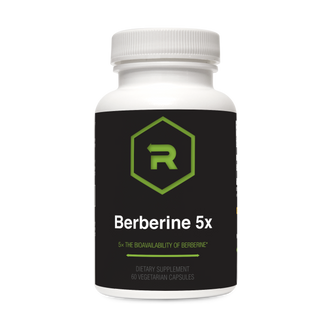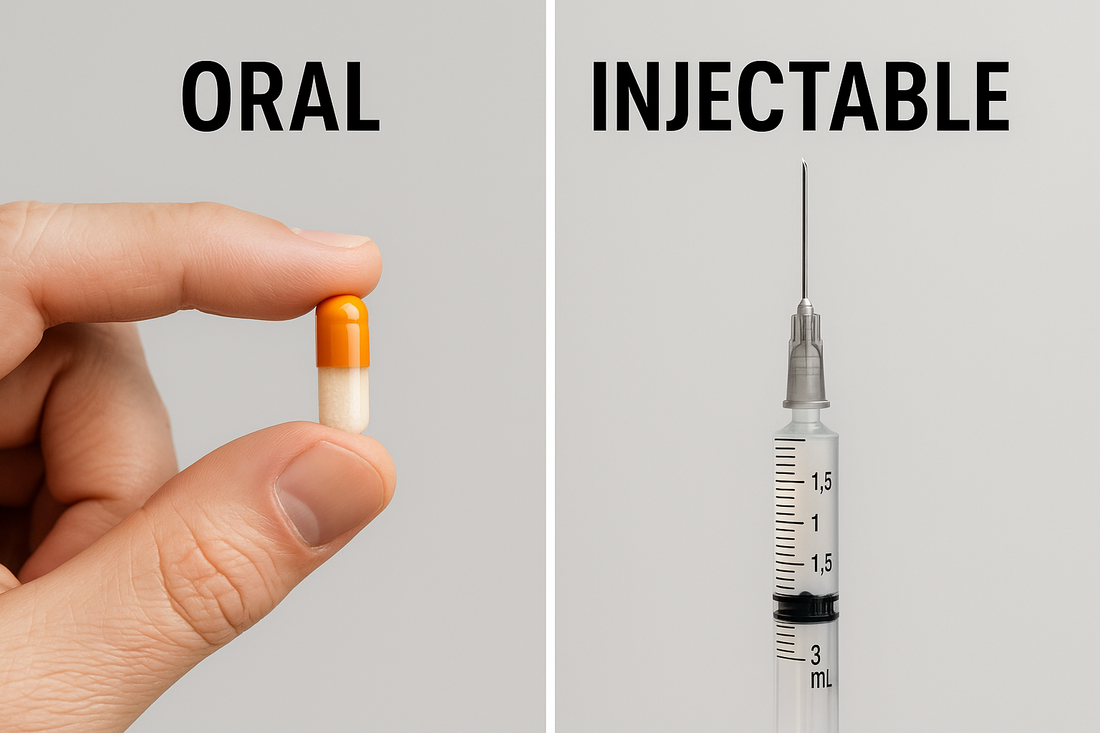Oral vs. Injectable BPC-157: Which Form Works Best for Healing and Recovery?
Few peptides have gained as much attention as BPC-157, a naturally derived compound known for its remarkable ability to accelerate healing, reduce inflammation, and protect the gut lining. Often referred to as the “body protection compound,” BPC-157 originates from a protective protein in gastric juice. It supports cell regeneration, collagen production, and angiogenesis—making it a powerful therapeutic for both internal and external injuries.
But one question continues to divide the functional and regenerative medicine community: Is oral or injectable BPC-157 better?
At Revolution Health & Wellness, we’ve seen both forms provide outstanding results—but for different reasons. In our experience, oral BPC-157 tends to deliver superior results for gastrointestinal repair, while injectable BPC-157 offers a more pronounced systemic effect for musculoskeletal healing, inflammation reduction, and vascular protection.
In this post, we’ll explore both delivery routes in detail, reviewing the pros, cons, mechanisms, and best-use cases for each form—so you can make an informed decision about which may be right for you.
Understanding BPC-157: A Healing Powerhouse
BPC-157 (Body Protection Compound-157) is a 15–amino acid peptide fragment derived from a protein found in the human stomach. It’s part of the body’s innate defense system—playing a critical role in maintaining the integrity of the gastrointestinal tract and promoting tissue repair throughout the body.
Mechanisms of Action
Scientific research has revealed that BPC-157:
-
Enhances angiogenesis (formation of new blood vessels), supporting oxygen and nutrient delivery to damaged tissues.
-
Upregulates growth factors such as VEGF (vascular endothelial growth factor) and FGF (fibroblast growth factor), accelerating wound repair.
-
Modulates nitric oxide (NO) pathways, improving circulation and reducing oxidative stress.
-
Protects endothelial cells and mitigates damage caused by toxins, stress, and inflammation.
-
Stimulates collagen synthesis, crucial for tendon, ligament, and muscle healing.
-
Regulates gut-brain communication, reducing inflammatory cytokines and protecting the enteric nervous system.
These mechanisms explain why BPC-157 has shown potential in diverse areas—from ulcer healing and leaky gut repair to tendon and joint recovery, nerve regeneration, and even neuroprotection.
Routes of Administration: Oral vs. Injectable
Because BPC-157 is a peptide, its delivery method significantly influences absorption and bioavailability. Peptides are delicate molecules easily broken down by digestive enzymes, so the way they enter the bloodstream matters.
Oral BPC-157
Oral formulations are typically encapsulated or enteric-coated, protecting the peptide as it passes through the stomach. This allows it to act directly on the gastrointestinal lining—where it naturally originates and exerts many of its effects.
Injectable BPC-157
Injectable versions are reconstituted with sterile or bacteriostatic water and administered subcutaneously (SubQ) near the area of injury or systemically in the abdomen. This bypasses digestion entirely, allowing the peptide to enter circulation and reach tissues throughout the body.
Both forms can be highly effective—but they tend to excel in different therapeutic contexts.
The Case for Oral BPC-157
1. Gut Healing and Mucosal Repair
Oral BPC-157 shines in treating gastrointestinal disorders. Because it originates in gastric juice, its natural target tissues are the stomach, small intestine, and colon.
Studies demonstrate oral BPC-157’s ability to:
-
Accelerate healing of gastric ulcers and intestinal anastomoses.
-
Reduce inflammation in ulcerative colitis and IBS-like conditions.
-
Protect against NSAID- and alcohol-induced mucosal injury.
-
Strengthen tight junctions, reducing intestinal permeability (“leaky gut”).
Clinically, we often observe that oral BPC-157 offers superior outcomes for patients with GI inflammation, bloating, food sensitivities, or irritable bowel symptoms. This form delivers the peptide exactly where it’s needed—within the gut lumen—allowing it to interact with local receptors and immune cells.
2. Localized Action with Minimal Systemic Exposure
Because it primarily acts within the GI tract, oral BPC-157 minimizes systemic exposure, making it appealing for individuals focused on gut restoration rather than full-body repair. This can be an advantage for those seeking a gentler introduction to peptide therapy or with sensitivities to injections.
3. Neuroprotective and Anti-Anxiety Effects via the Gut-Brain Axis
Emerging data suggest oral BPC-157 may modulate the gut-brain axis, influencing neurotransmitter balance and reducing anxiety-like symptoms. Animal studies show enhanced dopamine and serotonin signaling and improved resilience under stress. This makes oral administration an interesting choice for those dealing with stress-induced GI dysfunction or inflammatory bowel conditions linked to mood disorders.
4. Convenient and Non-Invasive
Of course, convenience matters. Oral administration is simple, painless, and non-invasive, making it ideal for patients hesitant about self-injection. Compliance rates tend to be higher—an important consideration for long-term healing.
Limitations of Oral BPC-157
Despite its benefits, oral delivery has certain drawbacks:
-
Lower systemic absorption: Only a fraction of the peptide survives digestion and reaches circulation.
-
Slower systemic results: For musculoskeletal injuries or systemic inflammation, oral dosing may be less effective.
-
Potential degradation: Depending on formulation, some BPC-157 can be degraded by stomach acid before reaching the small intestine.
In short, oral BPC-157 excels in gastrointestinal repair but may be less potent for tendon, ligament, or full-body recovery.
The Case for Injectable BPC-157
Injectable administration bypasses digestion, allowing BPC-157 to circulate systemically and target distant tissues. This makes it the preferred choice for injuries, inflammation, or vascular healing outside the gut.
1. Enhanced Bioavailability and Systemic Reach
Injecting BPC-157 directly into subcutaneous tissue ensures high bioavailability, avoiding enzymatic degradation. From there, the peptide circulates throughout the body, reaching joints, tendons, and nerves that need repair.
This systemic effect explains why injectable BPC-157 consistently produces faster and more dramatic healing in cases of:
-
Muscle tears and tendonitis
-
Ligament sprains
-
Post-surgical recovery
-
Nerve injury and neuropathy
-
Systemic inflammatory conditions
At Revolution Health, we often find that injectable BPC-157 provides slightly better systemic outcomes, accelerating healing across multiple tissues simultaneously.
2. Local Targeting for Injuries
Injections can also be administered locally near the site of injury, concentrating the peptide’s effects. For example:
-
Around a strained Achilles tendon
-
Near a rotator cuff injury
-
SubQ in the abdomen for systemic inflammation
Localized delivery may enhance growth factor expression and collagen synthesis directly at the site of damage.
3. Potent Anti-Inflammatory and Vascular Effects
BPC-157 promotes nitric oxide synthesis and reduces pro-inflammatory cytokines (IL-6, TNF-α). When injected, these benefits extend to vascular endothelium, muscle tissue, and connective structures throughout the body. Patients often report improved recovery times, decreased soreness, and better exercise tolerance.
4. Synergy with Other Peptides
Injectable BPC-157 can be combined synergistically with other regenerative peptides such as:
-
TB-500: Enhances actin polymerization and cell migration for tissue repair.
-
KPV: Potent anti-inflammatory tripeptide that complements BPC-157’s GI and immune benefits.
-
GHK-Cu: Promotes collagen remodeling and wound healing.
Such combinations amplify systemic healing, making injectables ideal for multi-tissue recovery and anti-aging protocols.
Limitations of Injectable BPC-157
-
Needle aversion: Some patients are uncomfortable with injections, leading to lower adherence.
-
Risk of minor injection site irritation: Local redness or small nodules can occasionally occur.
-
Shorter stability post-reconstitution: The peptide should be refrigerated and used promptly to preserve potency.
-
Systemic rather than localized gut focus: While injectables can still benefit GI health indirectly, they are not as targeted to the mucosal lining as oral forms.
In other words, injectable BPC-157 is optimal for musculoskeletal or whole-body recovery, but less efficient at directly repairing the gut barrier.
Comparing the Two: A Side-by-Side Summary
| Feature | Oral BPC-157 | Injectable BPC-157 |
|---|---|---|
| Primary Target | GI tract, mucosal lining | Muscles, tendons, ligaments, systemic tissues |
| Mechanism of Action | Localized gut repair, microbiome modulation, mucosal healing | Systemic regeneration, angiogenesis, anti-inflammatory |
| Absorption | Partial (enteric-protected) | Near complete (SubQ) |
| Onset of Action | Slower, cumulative | Faster, noticeable within days |
| Duration of Effect | Sustained gut improvement | Rapid tissue recovery, shorter duration per dose |
| Ease of Use | Non-invasive, convenient | Requires injection technique |
| Best For | Leaky gut, IBS, gastritis, ulcer, intestinal inflammation | Tendonitis, joint injury, systemic inflammation, recovery |
| Common Protocol | Daily oral capsule | Daily SubQ injection for 30–90 days |
| Side Effects | Rare (GI upset possible) | Mild irritation at injection site |
| Clinical Preference | Better GI results | Better systemic effects |
Which Form Is Right for You?
Choose Oral BPC-157 If You’re Focused On:
-
Healing leaky gut, gastritis, or IBS
-
Reducing food sensitivities and inflammation
-
Supporting gut-brain balance and mood
-
Improving digestion or post-antibiotic recovery
-
Maintaining results after an injectable series
Choose Injectable BPC-157 If You’re Focused On:
-
Accelerating tissue and tendon healing
-
Recovering from injury or surgery
-
Enhancing athletic performance and recovery
-
Reducing systemic inflammation and oxidative stress
-
Pairing with other injectable peptides for comprehensive regeneration
Some patients even combine both forms—using oral BPC-157 to support gastrointestinal health while taking injectables for systemic repair. This dual approach can be particularly effective for athletes, post-surgical patients, or those with inflammatory bowel disease plus joint pain.
The Clinical Perspective: Experience Matters
In our clinical experience at Revolution Health & Wellness, patients who use both forms strategically tend to achieve the best long-term results:
-
Those with GI complaints (bloating, food reactivity, IBS, reflux) often respond best to oral BPC-157 first, then may transition to injectables later.
-
Those with musculoskeletal injuries or systemic inflammation (joint pain, chronic fatigue, overuse injuries) often see faster improvement with injectable BPC-157, sometimes combined with TB-500 for enhanced tissue regeneration.
It’s important to remember that BPC-157 is not FDA-approved, and formulations should only be obtained through a licensed medical provider. All BPC-157 peptides dispensed by our clinic are produced in FDA-monitored facilities and intended for physician-supervised research and therapeutic use only—not for purchase from online “research” sources, which often contain impure or mislabeled products.
For those seeking guided peptide therapy, our experienced medical team designs personalized protocols based on clinical goals, medical history, and lab results.
Optimizing Your Results
Regardless of the route of administration, healing outcomes improve dramatically when BPC-157 is paired with lifestyle and nutritional support:
-
High-quality protein intake to supply amino acids for tissue repair.
-
Anti-inflammatory diet emphasizing omega-3s, polyphenols, and antioxidants.
-
Targeted supplements such as Curcumin Complex, Omega 1300, and ActiveMulti.
-
Adequate sleep and stress management, as both cortisol and oxidative stress can slow tissue recovery.
-
Low-impact exercise and physical therapy to encourage circulation and collagen remodeling.
Healing is a holistic process. BPC-157 can be a catalyst—but the foundation lies in restoring balance across diet, movement, rest, and stress response.
Final Thoughts
Both oral and injectable BPC-157 are exceptional tools in regenerative medicine, offering overlapping yet distinct benefits.
-
Oral BPC-157 is best for gut and mucosal healing, supporting the body from the inside out.
-
Injectable BPC-157 is best for systemic tissue repair, inflammation control, and vascular recovery.
Ultimately, the most effective approach depends on your specific goals—and often, a combination of both forms delivers the most comprehensive results.
If you’re curious about which form is right for you, our team at Revolution Health & Wellness can help design a peptide protocol tailored to your needs.
Explore BPC-157 at Revolution Health
Learn more about this powerful peptide and how it can fit into your healing and recovery plan:
👉 BPC-157 Peptide Therapy
Scientific References
-
Sikiric P, et al. "Stable gastric pentadecapeptide BPC-157: Novel therapy in gastrointestinal tract and other organ systems." Curr Pharm Des. 2011;17(16):1612–1632.
-
Seiwerth S, et al. "BPC 157 and the healing of muscle, tendon and ligament injuries." Curr Pharm Des. 2018;24(18):1982–1999.
-
Park JM, et al. "Protective effect of BPC-157 on gastric mucosal damage induced by alcohol in rats." J Physiol Pharmacol. 2008;59(2):349–362.
-
Jelovac N, et al. "The influence of BPC 157 on nitric oxide synthesis in various models of inflammation and organ injury." Life Sci. 2018;192:173–179.
-
Gwyer D, et al. "BPC-157 in musculoskeletal healing: Mechanisms and potential clinical applications." Front Pharmacol. 2020;11:577280.
-
Sikiric P, et al. "BPC 157 and the gut-brain axis: Implications for neuroprotection and mental health." Front Neurosci. 2021;15:659003.


